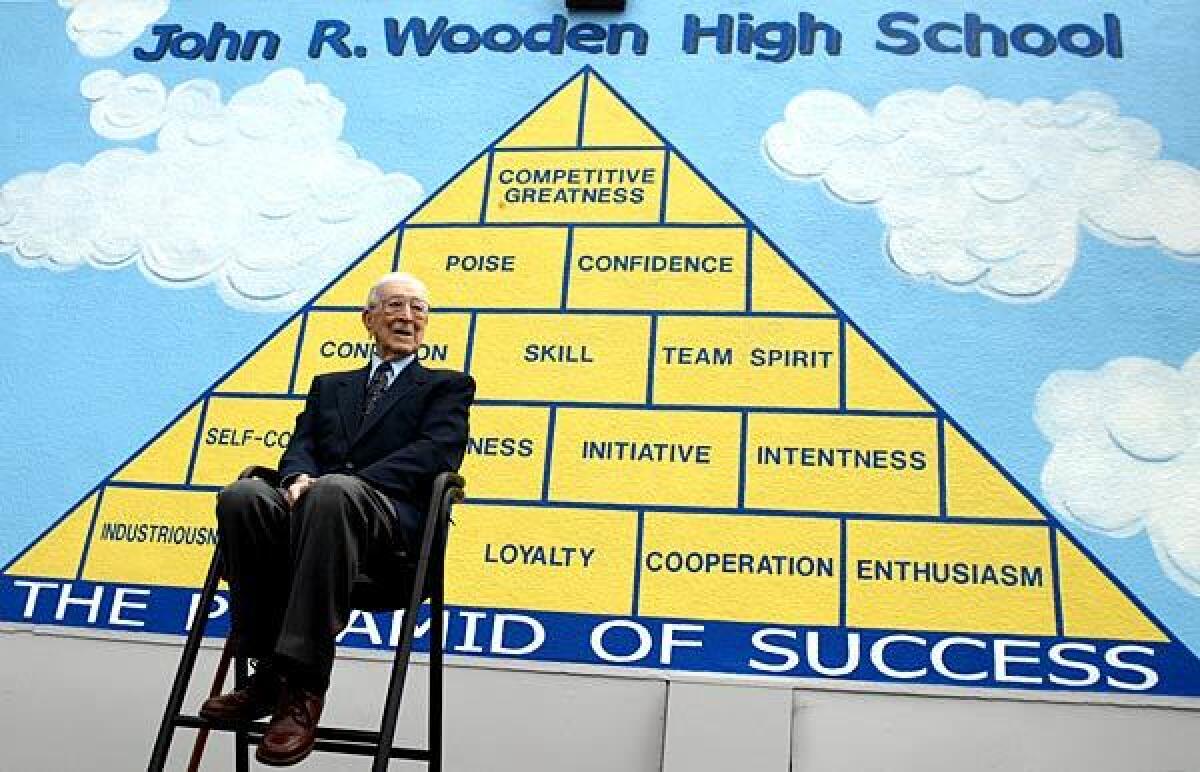John Wooden’s pyramid stands test of time

See full story
John Wooden was a young high school teacher and coach in the 1930s when he first wrote his personal definition of success, searching for a way to assure his students — and their parents — they could be successful without earning all A’s.
“I wanted to give them something to aspire to beyond higher marks in English classes or more statistics in sports,” he told The Times in 2004.
Wooden tied success not to achievement, wealth or fame, but to how close a person came to their potential.
He spent another 14 years completing his Pyramid of Success, tinkering with 15 building blocks such as “Industriousness” “Enthusiasm,” “Skill,” and “Poise,” before finishing the diagram in 1948, shortly before he left Indiana State for UCLA.
More than half a century later, the 10 national championship banners won by Wooden’s UCLA basketball teams hang from the rafters at Pauley Pavilion — and his old-fashioned but still resonant Pyramid of Success adorns everything from classroom walls at Mariners Elementary in Newport Beach to books, websites, mouse pads, even a wall in a Torrance collection agency.
Even well into his 90s, Wooden used to mail out some 1,500 copies of his pyramid a year, many of them to high school coaches who wanted to distribute them to their teams.
Though others urged him to copyright the pyramid, Wooden said in recent years he never had, prompting a friend to tell him he didn’t have a marketing bone in his body.
“I hope not,” Wooden said.
Completed during the Truman administration, the Pyramid of Success has improbably stood the test of time.
Stephen R. Covey, the bestselling author of “The 7 Habits of Highly Effective People” is an admirer of Wooden’s who has called the pyramid and Wooden’s other maxims “classic wisdom.”
It resonates not only with nostalgic mid-career workers in motivational seminars, but with 21st-century schoolchildren.
In January 2005, at 94, Wooden visited the Newport Beach elementary school where teacher Pat McLaughlin, a UCLA graduate, created a character-education program based on Wooden’s pyramid and his 2003 children’s book, “Inch and Miles: The Journey to Success.”
“It was fun. He was a good man,” Mariners Elementary student Brandy Joyce said later that year. “He said something funny I didn’t understand — it was only for the grown-ups.”
After Wooden’s visit, essays graced the walls of McLaughlin’s Room 13.
“Self-control sounds like not yelling the answer when it’s not your turn,” Cole Chapin wrote.
Nick Meier described himself as someone who “has Skill in building forts with Legos, who has self-control when my brother breaks something,” and Sydney Elliott-Brand considered herself someone who is “determined to pass division” and “has self-control when my sister pulls my hair.”
Elementary school students embrace the values of the pyramid easily.
But on the protest-roiled UCLA campus of the 1960s, it at first seemed hopelessly out of date to players such as future NBA great Lew Alcindor, now known as Kareem Abdul-Jabbar.
“He has said when he first heard it he thought it was corny,” Wooden told The Times in 2004. “It was not until he was out of school that it was meaningful.”
Far from drilling his players on the blocks of his pyramid as diligently as he did on the famous UCLA high-post offense, Wooden said he discussed it with the team as a group only once a year, at the beginning of each season.
Those who played for him had the benefit of many, many hours with Wooden and more often mention sayings such as “Be quick but don’t hurry,” and “Failing to prepare is preparing to fail.”
Bill Walton, who went on to become one of the best players in NBA history and is now an ABC and ESPN analyst, used to write Wooden’s maxims on his four sons’ lunch bags. (One of them, Luke, grew up to play for the Lakers.)
Yet for those who never had much interaction with Wooden, the pyramid was the map to his philosophies.
At McChord Air Force Base near Tacoma, Wash., a group of Western Air Defense Sector personnel spent three days in 2004 studying the pyramid.
“The pinnacle — Competitive Greatness — that is a tough but attainable goal,” Lt. Col. Eric Vogt said at the time. “I found myself thinking about how to be competitively great as much as possible. In the military, it’s got to be 100% perfect response every day. With our mission, there’s no room for error.”
Though it was as a teacher that Wooden began working on the pyramid, the beginnings of the idea were sown earlier, by a high school teacher who asked his class to define success, by his father’s emphasis on doing your best without comparing yourself to others, and by a diagram of values used by his high school coach, Glenn Curtis, called the Ladder of Achievement.
Instead of a ladder, Wooden chose a pyramid, with “Industriousness” and “Enthusiasm” as its cornerstones.
Late in life, as he celebrated the arrival of more and more great-grandchildren, Wooden took particular satisfaction in the children’s book, “Inch and Miles,” he wrote with his frequent collaborator, Steve Jamison.
In the children’s pyramid, “Industriousness” became “Hard Work,” “Initiative” became “Action,” and “Competitive Greatness” became “Personal Best.”
“My definition of success for a child is happiness in your heart, knowing you tried your best,” Wooden said in 2004.
The book incorporated Wooden’s love of rhyming couplets, with a short poem on each block of the pyramid.
The wittiest might be the one on self-control, accompanied by an illustration of a rather impulsive-looking trout.
If success is your great goal,
You must practice Self-Control.
Use common sense in all you do.
Controlling emotions is helpful too.
I knew a fish who took the bait.
Good judgment gone, the hook he ate.
My friend was fried upon the grill.
With Self-Control, he’d be here still.
His long life nearing its end, in 2004 Wooden considered the likelihood that his Pyramid of Success would be studied by children and adults for decades after his death.
“If it helps somebody, I hope I’ll be looking down and thinking it’s good,” he said.
This article was originally published on June 5, 2010.
More to Read
Get our high school sports newsletter
Prep Rally is devoted to the SoCal high school sports experience, bringing you scores, stories and a behind-the-scenes look at what makes prep sports so popular.
You may occasionally receive promotional content from the Los Angeles Times.






